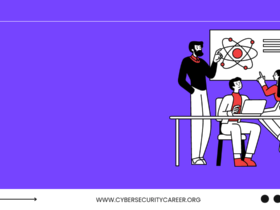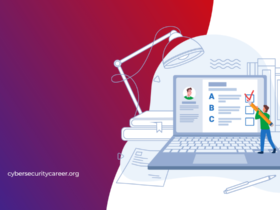What Kind Of Risk Is Cyber Security?
Cyber security is one of the most important considerations for any business. Cyber criminals are constantly developing new ways to attack businesses, and the consequences can be devastating. In this article, we’ll take a look at some of the different types of cyber security risks, and discuss how businesses can mitigate them.
The Different Types of Cybersecurity Risks
Cybersecurity is a big topic and there are many different types of cybersecurity risks. This article will focus on four different types of cybersecurity risks: online threats, physical threats, insider threats, and data breaches.
- Online Threats: Online threats are the most common type of cybersecurity risk. They come from people who want to attack your computer or steal your information. Examples of online threats include viruses, hackers, and spam emails.
- Physical Threats: Physical threats come from things like bombs, fires, and floods. They can damage your computer or steal your information. Physical threats can also cause injuries.
- Insider Threats: Insider threats are people who have access to your computer or information. These people could be employees or friends who you trust. Insider threats can steal your information or use it to attack you.
- Data Breaches: Data breaches are when someone steals your personal information (like your name, address, email address, and password). A data breach can happen at any stage of a company’s life—from planning stages to after the fact.
How to Mitigate Cybersecurity Risks?
What is the best way to mitigate cybersecurity risks? There is no one answer to this question, as the best way to protect oneself against cyberattacks will vary depending on the individual and their specific situation. However, some general tips on mitigating cyberrisk include:
- Educate yourself about cyber threats and how to avoid them. Familiarize yourself with common types of cyber attacks and how they work, as well as the potential consequences of getting hacked. This will help you better understand why it’s important to take precautions against cyberattack and what you can do to protect yourself.
- Install anti-virus software and firewall protection on your computer. These tools can help identify and prevent malicious software from infecting your computer, as well as blocking unauthorized access from the internet.
- Keep up-to-date with the latest security patches and updates for your programs and devices. Make sure that you are using the most recent versions of programs and devices, and install any updates that are available. This will help protect you against known vulnerabilities and attacks.
- Use strong passwords and keep them confidential. Create complex passwords that contain at least eight characters, use different types.
What Is a Cyber Security Threat?
When it comes to cyber security, the stakes are high. Cyber crime costs the global economy an estimated $430 billion each year, and damages businesses’ reputations, customer relations, and other intangible assets.
There are a number of different types of cyber threats, but all of them stem from unauthorized access to computer networks or data. Here are three examples:
- Data theft: This is the most common type of cyber threat, and it revolves around stealing information like customer data, intellectual property, and trade secrets.
- Cyber espionage: This involves hackers stealing proprietary information from businesses competitors or government agencies.
- Cyber terrorism: This is when attackers use cyber attacks to cause physical destruction or damage to critical infrastructure like power grids or transportation networks.
The best way to prevent these types of attacks is to have a comprehensive cyber security plan in place that includes measures like password protection, firewalls, and virus scanning.
Evolution of Cyber Security
As cyber security evolves, so too does the risk associated with it. Here’s a look at some of the most common types of cyber security risks and what you can do to mitigate them.
Understanding the Types of Cyber Threats
Cyber security is a serious matter, and you need to be aware of the different types of cyber threats if you want to stay safe. Here are four of the most common types:
- Viruses: Viruses can spread through email and other online means, and can cause damage to your computer or data. There are many varieties of viruses, so it’s important to be aware of the signs that you have been infected and take appropriate steps to protect yourself.
- Spammers: Spammers can bombard your email inbox with unwanted messages, which can cost you time and money. You can help stop spam by using filters on your email account and setting up rules for what emails get sent to your mailbox.
- Attackers: Attackers use cyberattacks to steal information or attack other websites. They may also try to gain access to your computer in order to steal personal information or commit other crimes.
- Hackers: Hackers are people who use their skills in computers to break into systems and steal data or money. They may do this for fun, or they may do it in order to commit crimes such as theft or fraud.
16 Types of Cyber Security Threats
Here is the list of 16 types of cybersecurity threats with complete overview.
#1. Malware
Cyber security is a growing concern for businesses of all sizes. Cybercrime is on the rise, and risk posed by malware is one of the most serious threats.
Malware is a type of virus that targets computers. It can damage files, delete data, and interfere with online activities. Malware can also steal financial information or contact lists from infected computers.
There are several ways to protect yourself from malware attacks. You can install antivirus software on your computer, keep up to date with security patches, and use strong passwords. You can also protect your computer with a firewall and password protection.
Cybersecurity is a growing concern for businesses of all sizes. Cybercrime is on the rise, and risk posed by malware is one of the most serious threats. By taking measures to protect your computer against malware, you can reduce the risk of a cyberattack and protect your privacy and data.
#2. Password Theft
A lot of people don’t think about cyber security when it comes to their personal information. However, cyber security is a serious issue that needs to be taken seriously.
One of the most common ways that cyber security is compromised is through password theft. Criminals will often try to guess your passwords in order to access your accounts online. This can result in them being able to steal your personal information, steal your money, or even commit financial fraud.
Another way that cyber security is compromised is through hacking. Hackers will often try to break into your computer in order to steal your data or exploit vulnerabilities in order to gain access to your computer network.
Cyber security is an important issue that everyone should take seriously. By using strong passwords and keeping your computer secure, you can protect yourself from the risk of cyber security breaches.
#3. Traffic Interception
Cybersecurity is a growing concern for businesses of all sizes. There are several ways that a cyberattack can impact a business, and the costs of dealing with a cyberattack can be high.
One type of cyberattack is traffic interception. This is when hackers access your computer or phone and steal your traffic data. They can then use this data to hijack your traffic, making your site or app load slowly or causing you to lose money.
This type of cyberattack can also damage your reputation and lead to lost customers. In some cases, it can even damage your business’s ability to operate.
To avoid becoming a victim of traffic interception, make sure that your site and app are protected from attacks. You can also use security measures such as passwords, Two-factor authentication and firewalls. By taking these precautions, you’ll protect your business from the risk of cyberattacks.
#4. Phishing Attacks
Phishing is a type of attack where hackers try to trick you into giving them your username and password.
Cybersecurity is the practice of protecting your information from being stolen or damaged by hackers. This includes protecting your username and password, as well as other important information.
Phishing attacks are one way hackers can steal your username and password. They do this by sending you an email that looks like it comes from a trusted source, like your bank or credit card company.
If you click on the link in the email, you’ll give away your username and password to the hacker. This can then be used to steal your information or to damage your computer.
Cybersecurity is essential for anyone who uses online services. By taking simple steps like not clicking on suspicious links, you can protect yourself from phishing attacks and other types of cyberattacks.
#5. DDoS
Cybersecurity is an increasingly important topic, and it’s no secret that companies are worried about the risks posed by cyberattacks. A data breach can have a severe impact on a company’s reputation, finances, and operations.
Understanding the different types of cyberattacks is key to mitigating these risks. A data breach caused by a DDoS attack is one of the most common types of cyberattacks. A DDoS attack involves flooding a target with traffic in order to crash its systems or cause them to go offline.
DDoS attacks can be difficult to prevent, but there are several steps that companies can take to protect themselves. First, they should deploy a Cybersecurity Strategy that focuses on identifying and mitigating risk. They should also implement robust security measures, such as firewall, intrusion detection system (IDS), and anti-spyware software. Finally, they should have a plan in place for responding to a DDoS attack.
#6. Cross Site Attack
Cyber security is a hot topic these days, with attacks on major companies like Target and Home Depot becoming more frequent. But what exactly is cyber security, and how risky is it?
In a nutshell, cyber security is the protection of your computer systems from unauthorized access, theft, or destruction. It includes measures such as installing updates and antivirus software, protecting your computer against viruses and other malware, and keeping your computer secure against hackers.
Cyber security is definitely a risk-factor in today’s world. In fact, one study found that cybercrime costs businesses around $650 billion annually! That’s a lot of money – and it can easily be lost if your computer systems are compromised by cyber criminals.
So if you’re concerned about the risk of cyber security attacks, make sure you take appropriate measures to protect yourself. And remember – you can always call our team of experts if you need help protecting your computer system from attack. We’d be happy to help!
#7. Zero-Day Exploits
Cybersecurity is a growing concern for businesses of all sizes. Statistics show that cybercrime costs businesses an estimated $600 billion each year.
One of the most common types of cyberattacks is known as a “zero-day exploit”. This is when a hacker discovers a vulnerability in a software program and uses it to attack other people or businesses.
There are several ways to protect yourself from zero-day exploits. You can use a software program that monitors your computer for suspicious activity. You can also install antivirus software on your computer and keep updated with the latest security patches.
Cybersecurity is a growing concern, but it’s not impossible to protect yourself from cyberattacks. By taking these simple steps, you can reduce the risk of becoming a victim of cybercrime.
#8. SQL Injection
SQL injection is a type of attack that targets the SQL (Structured Query Language) used by many websites to store and manage data.
SQL injection attacks allow hackers to inject malicious code into web requests made by users visiting the website. This code can then be used to control the actions of the website user or even access sensitive data.
SQL injection attacks are particularly dangerous because they can be carried out without the user knowing. This means that they can be carried out by anyone, including unauthorized employees or third-party contractors working on the website.
If you are ever worried about your online security, it is important to know about SQL injection attacks and how to protect yourself against them. Always use caution when filling in forms on websites and be sure to check the security settings of your browser before submitting information.
#9. Social Engineering
Cybersecurity is a growing concern for businesses of all sizes. Here are three ways social engineering can put your company at risk.
1. Social Engineering Through Email
One common way that cybercriminals try to attack companies is by sending them unsolicited emails. These emails may appear to be from a trusted source, like a vendor or customer service department.
If you’re not careful, you could fall for this type of social engineering attack. Be sure to only accept email from known sources and verify the sender before opening an attachment or clicking on a link in an email.
2. Social Engineering Through Website Access
Cybercriminals also use social engineering to gain access to company systems. They may trick employees into giving them login credentials or other sensitive information.
Be sure to keep your website security measures up-to-date and make sure only authorized employees have access to company systems. You can also install security software on your computer and mobile devices to help protect them from cyberattacks.
3. Social Engineering Through Phishing Attacks
Phishing attacks are another form of social engineering that criminals use to steal personal information from company employees. They may send spoofed emails that look like they come from legitimate sources.
#10. MitM Attack
Cyber security is one of the most important concerns for businesses today. A cyber attack can ruin a company’s reputation and damage its finances. It can also lead to loss of data, loss of customers, and even loss of jobs.
There are several different types of cyber attacks. One type is called a MitM attack. In a MitM attack, the attacker “hides in the middle” between the victim and the target. This makes it difficult for the victim to detect the attack and protect themselves.
MitM attacks are becoming increasingly common, and businesses need to be aware of them. Businesses should have a policy in place that addresses MitM attacks. They should also have procedures in place to identify and protect against MitM attacks.
#11. Ransomware
Cyber security is a growing concern for businesses of all sizes. In today’s world, there are countless ways for hackers to steal information or damage your computer system.
One of the most common types of cyberattacks is ransomware. This is a type of attack where hackers demand money from you in exchange for not damaging your computer system.
Ransomware can be very costly to deal with, and it can be difficult to know if you’re being attacked. That’s why it’s important to have a plan in place for dealing with ransomware.
Some tips for mitigating ransomware risks include:
- Regularly updating your software and firewall software.
- Keeping up-to-date on reports of new ransomware trends.
- Using strong passwords and encryption techniques.
- Contacting your IT professional if you notice any suspicious activity on your computer system.
#12. Cryptojacking
Cybersecurity is a big risk these days. With so many people using the internet, there is always the potential for cyberattacks.
Cryptojacking is a type of cyberattack that involves stealing information from users through their computers. This can include their personal information, passwords, and other sensitive information.
Cryptojacking can be done in two ways: by attacking websites and stealing their users’ cookies, or by attacking their computer directly and stealing their data.
Cryptojacking has become a big problem because it allows criminals to steal money and information from unsuspecting users. It’s important to stay informed about cybersecurity risks, and to use safe online habits to protect yourself.
#13. Water Hole Attack
Cyber security is one of the most important aspects of business today. It’s essential that businesses take measures to protect their data and systems from cyber attacks.
A water hole attack is a type of cyber attack that’s aimed at stealing data from a company or individual. The attacker targets employees who are likely to have access to valuable information, such as customers or financial records.
The attacker sends them an email that looks like it’s from a trusted source. The email asks the employee to click on a link in the email. If the employee clicks on the link, they’ll be taken to a fake website that looks like it belongs to the company or individual they work for.
The attacker then phishes (stealing personal information) from the employee, including their login credentials and other sensitive information. Once they have this information, the attacker can access all of the information on the victim’s computer system.
Water hole attacks are becoming more common, so businesses need to take steps to protect themselves from them. One way to do this is by ensuring that employees are trained about how to identify fake emails and websites. They should also keep their passwords secure and never give out personal information without proper consent.
#14. Drive-By Attack
Cybersecurity is the practice of protecting computer systems and networks from unauthorized access, use, or destruction.
A drive-by attack is a type of cyberattack in which attackers exploit vulnerabilities in web applications and websites to send malicious commands to unsuspecting users without their knowledge. This type of attack can lead to the theft of personal information, financial data, and other sensitive information.
In a drive-by attack, attackers don’t have to get close to the target computer system. They can attack from a distance using automated tools. This makes drive-by attacks very difficult to detect and prevent.
Thefts caused by drive-by attacks can have a devastating impact on businesses and individuals. They can lead to the loss of important data, money, and business relationships.
To protect your computer system from drive-by attacks, you need to adopt a comprehensive cyber security strategy. This strategy should include measures such as password protection, firewalls, and virus protection. You also need to keep up with the latest security trends and update your software accordingly.
If you are concerned about your computer system’s susceptibility to drive-by attacks, you should consult with an experienced cyber security consultant.
#15. Trojan Virus
Cybersecurity is a growing issue that businesses must address. There are several types of risks that businesses face when it comes to cybersecurity, including cyber-attacks and data breaches.
A cyber-attack is when an attacker tries to damage or steal information from a business by using computer networks. Data breaches are when hackers break into a business’s computer systems and steal sensitive information, such as customer records.
Businesses must take steps to protect themselves from both cyber-attacks and data breaches. They can do this by installing security measures, such as firewalls and antivirus software. They can also use secure networking methods, such as VPNs, to protect their data from being stolen.
Overall, cybersecurity is a growing issue that businesses must address. By taking steps to protect themselves, they can avoid potential risks and remain safe online.
#16. Emotet
Cyber security is a growing concern for businesses of all sizes. Cybercrime is on the rise, and cyber attacks are becoming more sophisticated and widespread.
In this article, we will discuss the risks posed by cyber attacks, and how businesses can protect themselves from them. We will also describe the different types of cyber threats, and how to protect yourself from them.
Cybersecurity Risk
The first step in protecting yourself from cyber threats is understanding the risk. A cybersecurity risk is the potential for harm that could be caused by an attack or breach of your systems. The three main types of cybersecurity risks are human error, technical failure, and malicious action.
Human error is the most common type of cybersecurity risk. This occurs when someone makes a mistake that allows an attack or breach to occur. For example, a user might enter their login credentials incorrectly into a website, or leave their computer unlocked where an attacker could get access to it.
Technical failure occurs when your systems are not able to handle a cyberattack or breach properly. This could happen because your systems are not well protected against hackers, your systems are not up to date with the latest security patches, or you have inadequate procedures in place for responding.
Conclusion
Cybersecurity is a growing concern for businesses of all sizes. Unfortunately, there’s no one-size-fits-all answer when it comes to managing cyber risks, as the risk posed by different types of attacks will vary greatly.
That said, here are five general tips that can help you mitigate the risk of cyber attack:
- Educate your employees about cyber security threats and how to protect themselves.
- Implement a robust incident response plan in case of a breach.
- Create an effective malware detection and prevention strategy.
- Deploy an intrusion detection system (IDS) and use SIEM to monitor activity across your network perimeter.
- Develop a comprehensive business continuity plan to ensure that your business continues operating during an event or infiltration.










Leave a Reply